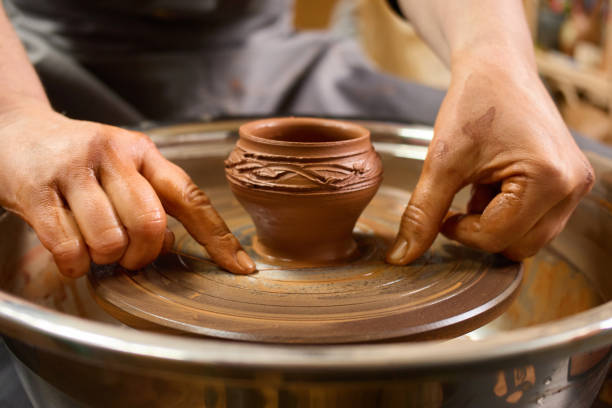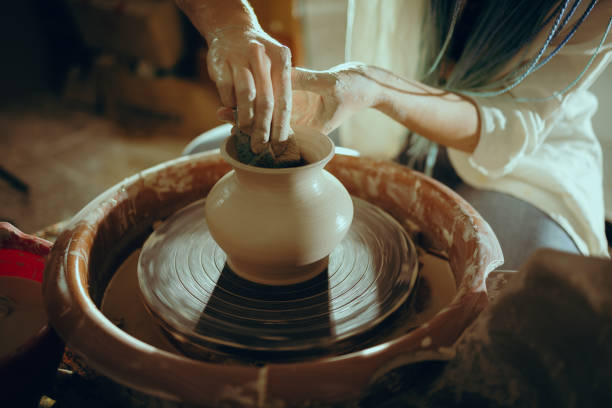Whether you’re a pottery beginner or a more advanced ceramicist, purchasing a potter’s wheel is an important investment. There are a number of different types of wheels to choose from, including electrical and manual-powered.
The best choice will depend on your present needs and future plans for pottery making. It is also essential to consider portability and cost.

Buying a Potter’s Wheel
Pottery wheels are surprisingly difficult to get the hang of. Ultimately the goal is to put clay on the wheel, centre it and keep it centered while you make something from it. For this reason, a new potter’s wheel can be an expensive purchase.
That said, there are a number of great options on the market for all budgets and skill levels. This guide is here to help you decide which one will be right for you.
First consider your budget and space. For beginners it is usually best to start with a cheap wheel like the Speedball Artista. This wheel will cost you around £500 and is easily transportable. This means you can take it with you to workshops or even do demos at shows.
Also consider your future plans for pottery. Will you be using it as a hobby only or will you eventually want to turn it into a full time gig? It is important to ask yourself these questions as you could find yourself paying a lot of money upgrading your wheel in the future.
It is also worth double checking how your wheel is powered and how the speed is controlled. Many potters are used to a foot pedal and changing to a hand lever can be tricky. It is also worth looking into whether your wheel has bat pins as some older style wheels don’t have them.
The Basics
Whether pottery is your side hustle or full time gig, you will want to start by investing in the right wheel. Buying a good quality wheel will save you from having to spend double the cost upgrading to a more advanced one later on.
The potter’s wheel consists of a flat disk that spins around, on which a potter puts soft clay to create shapes such as bowls and vases. The spinning disc generates centrifugal force to shape the clay as the potter applies pressure on the sides of the bowl with his hands.
Before the potter’s wheel, all ancient civilizations developed ceramics by hand-building techniques including pinching, coiling and paddling. The wheel offers additional opportunities for the potter to develop more rounded or symmetrical forms.
Most modern potter’s wheels have three feet/legs instead of four, because it is easier to balance the wheel on uneven floors. The feet are screwed in and out to adjust the height of the wheel on the floor, so that it can sit properly.
Some wheels have bat pins, which allow the potter to trim ware directly from the wheel head. These are useful for reducing the size of a piece, as well as to clean up the bottom of the pot. However, many older-style wheels don’t have bat pins, and the vast majority of competitively priced, unbranded potters wheels do not either.

The Cost
The best Potter’s wheels can be quite expensive, especially if you’re looking for a high-quality professional model. Fortunately, potter’s wheel there are also more budget friendly options that offer all of the essential functionality of a professional wheel but at a much more affordable price.
Using a potter’s wheel offers a number of benefits to the maker of pottery. Among them, it allows the potter to produce more pottery in less time and at a higher quality than if they were hand-building. Additionally, it’s much easier to trim the edges of a clay object with a wheel than with hand tools.
Potters also use their wheel to produce ceramic wares with more texture than possible through hand-building alone. One way they accomplish this is through a process called chattering, in which the potter uses a tool that gouges out small bits of clay at regular intervals on the surface of a bone dry pot. This creates a textured pattern that is distinct to each piece.
When selecting a potter’s wheel to purchase, consider the kind of pottery you plan to make, your long-term craft goals, and what conveniences are necessary for your work space. If you plan to work in a limited space, a tabletop wheel may be the best option as it’s more compact than a floor-mounted wheel and still provides all the throwing (working with clay on the wheel) functionality you need.
The Options
There is no one-size-fits all pottery wheel so if you’re thinking about purchasing your first one it’s important to do some research. Thankfully there are plenty of resources online and both physical and online retailers like Mid South ceramics that stock entry level wheels.
Some wheels are very compact and can easily be tidied away into a cupboard when not in use. These are great if you don’t have the space for something bigger. Others are quite large and bulky and require a dedicated studio space in your home or garage.
You’ll also want to consider what you intend on using the wheel for, for example if you plan on throwing large pots and platters with wide bases then you’ll need a larger flat wheel head. Some wheels have bat pins, which attach to the wheel head through holes and allow potters to throw ware without handling the wet clay directly. The number and distance of the bat pins on the wheel head can vary, but most come standard with 10” center pins.
Some potters prefer to use plaster bats instead of the standard plastic ones that are included with many wheels. However, these have their own disadvantages as they can crumble or become brittle with regular use and are more difficult to clean out.







